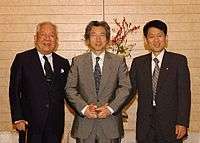Koichi Tanaka
| Koichi Tanaka | |
|---|---|
|
Koizumi Cabinet E-mail Magazine, No.81, February 6, 2003. | |
| Born |
3 August 1959 Toyama, Japan |
| Nationality | Japanese |
| Fields | Electrical Engineering, chemistry |
| Institutions | Shimadzu Corporation |
| Alma mater | Tohoku University |
| Known for | Soft laser desorption |
| Notable awards |
Keio Medical Science Prize (2002) Nobel Prize for Chemistry (2002) |
Koichi Tanaka (田中 耕一 Tanaka Kōichi, born August 3, 1959) is a Japanese engineer who shared the Nobel Prize in Chemistry in 2002 for developing a novel method for mass spectrometric analyses of biological macromolecules with John Bennett Fenn and Kurt Wüthrich (the latter for work in NMR spectroscopy).[1][2]
Biography
Tanaka was born and raised in Toyama, Japan. He attended Toyama Chubu High School in Toyama City. In 1983, he graduated from Tohoku University with a bachelor's degree in electrical engineering. After graduation, he joined Shimadzu Corporation, where he engaged in the development of mass spectrometers.
Soft laser desorption

For mass spectrometry analyses of a macromolecule, such as a protein, the analyte must be ionized and vaporized by laser irradiation. The problem is that the direct irradiation of an intense laser pulse on a macromolecule causes cleavage of the analyte into tiny fragments and the loss of its structure. In February 1985, Tanaka found that by using a mixture of ultra fine metal powder in glycerol as a matrix, an analyte can be ionized without losing its structure. His work was filed as a patent application in 1985, and after the patent application was made public reported at the Annual Conference of the Mass Spectrometry Society of Japan held in Kyoto, in May 1987 and became known as soft laser desorption (SLD).[3]
However, there was some criticism about his winning the prize, saying that contribution by two German scientists, Franz Hillenkamp and Michael Karas was also big enough not to be dismissed, and therefore they should also be included as prize winners.[4][5] This is because they first reported in 1985 a method, with higher sensitivity using a small organic compound as a matrix, that they named matrix-assisted laser desorption/ionization (MALDI).[6] Also Tanaka's SLD is not used currently for biomolecules analysis, meanwhile MALDI is widely used in mass spectrometry research laboratories. But while MALDI was developed prior to SLD, it was not used to ionize proteins until after Tanaka's report.[7]
See also
References
- ↑ Tanaka, K.; Waki, H.; Ido, Y.; Akita, S.; Yoshida, Y.; Yoshida, T. (1988). "Protein and Polymer Analyses up to m/z 100 000 by Laser Ionization Time-of flight Mass Spectrometry". Rapid Commun Mass Spectrom. 2 (20): 151–3. doi:10.1002/rcm.1290020802.
- ↑ "Biographical Snapshots of Famous Women and Minority Chemists: Snapshot". Retrieved 2008-08-18.
- ↑ Markides, K; Gräslund, A. "Advanced information on the Nobel Prize in Chemistry 2002" (PDF).
- ↑ Spinney, Laura (2002-12-11). "Nobel Prize controversy". The Scientist. Retrieved 2014-06-04.
Nobel Prize for Chemistry awarded amid protests that two of mass spectrometry's inventors overlooked
- ↑ Victor A. Gault; Neville H. McClenaghan (8 December 2008). Understanding Bioanalytical Chemistry: Principles and Applications. John Wiley & Sons. pp. 184–185. ISBN 978-0-470-71210-8.
- ↑ Karas, M.; Bachmann, D.; Hillenkamp, F. (1985). "Influence of the Wavelength in High-Irradiance Ultraviolet Laser Desorption Mass Spectrometry of Organic Molecules". Anal. Chem. 57 (14): 2935–9. doi:10.1021/ac00291a042.
- ↑ Karas M, Hillenkamp F (1988). "Laser desorption ionization of proteins with molecular masses exceeding 10,000 daltons" (PDF). Anal. Chem. 60 (20): 2299–301. doi:10.1021/ac00171a028. PMID 3239801.
External links
- The Nobel Prize in Chemistry 2002
- Nobel Prize Announcement (Shimadzu Corporation)
- Tanaka Nobel Prize lecture
- Biographical snapshots: Koichi Tanaka, Journal of Chemical Education web site.
- Koichi Tanaka

